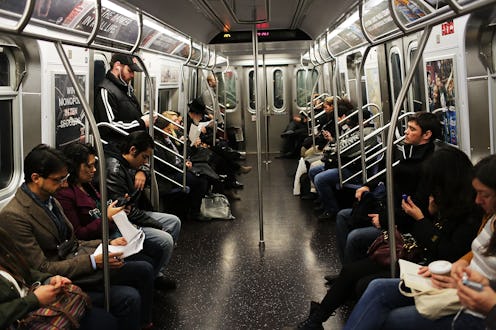When you live in a major city like New York, it's just a fact of life that you'll come into contact with a lot of weird things on a daily basis. Many of these encounters will occur on the subway — but did you know just how much bacteria the New York subway holds? Spoiler: It's a lot. And thanks to a team of enterprising scientists, we now have a better idea not only of what that number is, but, moreover, of the bigger picture surrounding the huge variety of organisms we live right next to, but can't even see.
Dr. Christopher Mason and his team recently published the results of an 18-month study of the New York subway system. In order to get a better handle on the city's ecology, they spent a year and a half gathering DNA from every turnstile, ticket kiosk, railing, and bench they could from the 466 stations currently open and operational. Then they sequenced the material (which totaled more than 10 billion fragments of biochemical code, by the way), sorted it with the help of a supercomputer, and compared the results to genetic databases of known bacteria and viruses. The data has been assembled in a nifty interactive over at the Wall Street Journal — so in case you've ever been curious about what your daily commute looks like from an invisible-to-the-naked-eye standpoint, now's your chance to find out.
Bacteria, by the way, is not inherently bad; sure, some of them can make you sick, but they also do things like help your stomach digest food. According to the Wall Street Journal, there every human being hosts a mind-blowing hundred trillion microbial cells — and what's more, they actually outnumber human cells about 10 to 1. Furthermore, the knowledge gained from the study wasn't just an interesting exploration into the secret lives of microbial organisms; it served a greater purpose as well. As Johnathan Eisen, an evolutionary biologist at the University of California at Davis, put it when speaking to the Wall Street Journal, “We know next to nothing about the ecology of urban environments. How will we know if there is something abnormal if we don't know what normal is?”
Roughly 5.5 million people use the subway every day, so it's probably not surprising that they found a huge number of organisms; all in all, there were 15,152 types of life-forms, about half of which belonged to bacteria. Most of the bacteria are harmless, though, so don't freak out — according to the researchers, the levels they detected aren't a danger to public health. The most commonly found bacteria ranged from antibiotic resistance (220 stations) to urinary tract infections (192 stations) and from food poisoning (215 stations) to mozzarella cheese (151 stations); and naturally, the more heavily trafficked stations had a lot more going on than the less frequently used ones.
Let's take a look at a few, shall we? I nabbed some screenshots of the data for a few of the stations I was most curious about; head on over to the Wall Street Journal to play around with the full interactive. It's worth it — I promise. You can sort the data either by station or by bacteria type — super interesting stuff.
Times Square-42nd Street:
Of course the tourist mecca that is Times Square would have a lot of wacky stuff floating around it; I think what I find most entertaining, though, is that among the bacteria for things like staph infections and urinary tract infections (I don't even want to know), there's also…Italian cheese. It actually makes sense when you stop to think about it, though; cheese becomes cheese with the help of bacteria, and I'm sure rather a large amount of people have chowed down on slices of pizza while waiting for their trains to arrive.
14th St-Union Square:
Well…huh. Somehow I was expecting Union Square to look more like Times Square. I guess not. Good to know that everyone is wearing their sunscreen, though, right?
59th St-Columbus Circle:
Not only is there Italian cheese here, but more specifically, there is also mozzarella. I assume the fact that urinary tract infection bacteria seems to be popping up so frequently is because an awful lot of people pee in subway stations. This isn't exactly a revelation, but nothing has ever made me consider the sheer numbers in which people must relieve themselves in public quite the same way this interactive has.
Atlantic Av-Barclays Ctr:
Wow. The subway station in Brooklyn I used to live by is almost as bacteria-ridden as Times Square. Didn't see that one coming. I would have been interested to see how the data would compare to what it was like before the Barclays Center went up, though; although Atlantic Ave houses a pretty big station, I'm sure more people use it now to get to and from the Beyoncé concerts and Brooklyn Nets games to which the venue plays host.
Aqueduct Racetrack:
In 2011, the Aqueduct Racetrack station in Queens was the least used subway stop in the entirety of New York City. As such, it's to be expected that it would have a relatively small number of microbial organisms living at it.
Check out the full interactive at the Wall Street Journal. Isn't science neat?
Images: johncartermd/Tumblr; The Wall Street Journal (5)
